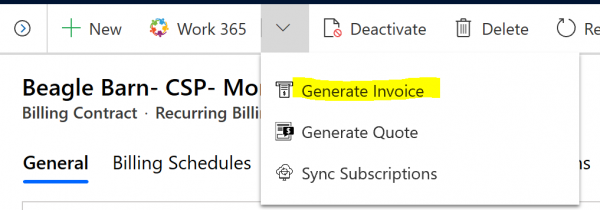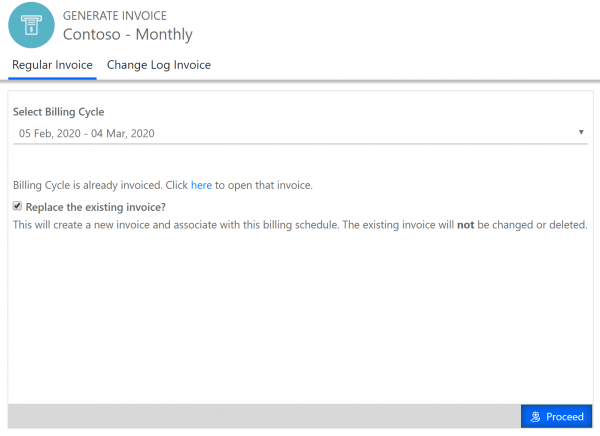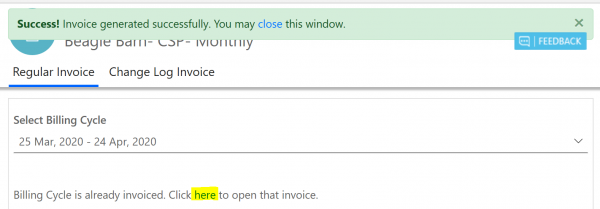Managing Billing Cycles
Billing Cycles are Managed through the Billing Schedule entity
Creating a Billing Cycle will not instruct the System to Generate an invoice
Billing Schedules are generated and tracked automatically by the Invoicing Process in Work 365
Billing Schedule Configuration Setting
Go to Work 365 ➤ Administration ➤ Configuration Settings ➤ Invoicing Cycle Range. defines how many billing schedules are automatically created in the future
Viewing Active Billing Schedules
To view all Active Billing Schedules go to Work 365 ➤ Billing and Invoicing ➤ Billing Schedules. Billing schedules can also be viewed via billing contracts as well.
The default view will show all active Billing Schedules.
Billing Schedules with a ‘Pending’ or ‘Error’ status reason are still considered active records.
Each Billing Schedule record will show the following:
General
- Billing Contract: the associated Billing Contract for the Billing Schedule
- Schedule Date: The date for which the invoice is scheduled to be generated as defined by the Next Invoice Date.
Billing Details:
- Name: Name of the Billing Schedule
- Cycle Start: Billing Schedule start date based on the billing cycle as defined by the Billing Contract start date.
- Cycle End: Billing Schedule start date based on the billing cycle as defined by the Billing Contract start date.
Run Details:
- Resulting Invoice: the associated invoice record to the current billing schedule
- Run Date: Date for which the Invoice was generated.
- Automatic invoice: run date will align with the billing cycle defined on the billing contract
- Manual Invoice: the day which the invoice was manually generated
- Run Type: Manual = manually generated invoice; automatic = automatically generated invoice
- Correlation ID: If there is an errored Billing Schedule, it will reference the error ID in this field.
- Message: This field will contain an error message if the invoice failed to generate.
Status Reason:
- Pending: Pending schedules are future billing schedules that are yet to be invoiced.
- These are generated on every invoicing cycle and the total number future schedules are based on the above-mentioned configuration.
- Error: The Billing Schedule is active, but the invoice failed to generate. The reason the invoice failed to generate will be listed in the message field.
- This would require attention and manual resolution.
Viewing Errored or Pending Billing Schedules
To view existing Billing Schedules go to Work 365 ➤ Dashboards ➤ change the view to the Work 365 Billing Administrator Dashboard ➤ View the Missed or Errored Schedules panel > Hit the panel ellipses and select see all records.
In this view:
- Billing Schedules with a Pending Status reason: Indicates an error occurred which prevented the invoice process from running resulting in a missed billing schedule with no error message.
a. Example: There was an update to the Work 365 Service Account which prevented the invoice run from completing.
b. expired credentials, password updated without redoing the consent process, or the Dynamics license being removed. - Billing Schedules with an Errored Status Reason: Indicates the invoice failed to run for this billing schedule, and thus the record is in an Errored active status. Generate a manual invoice for this billing cycle. The generated invoice should automatically link to this billing schedule. The billing schedule status reason will update to an “Invoiced” status to mark the billing schedule as completed.
a. Example: the billing contract end date was not renewed, therefore an invoice was not generated for the contract after the end date had expired. The invoicing cycle was missed in this case.
Invoicing scenarios:
- The system automatically generates an invoice for a billing contract. The system automatically associates this invoice record with an existing billing schedule. The billing schedule becomes an inactive record.
- Manually generating a new invoice for a billing cycle where an invoice already exists for that billing cycle
Go to Work 365 ➤ Billing and Invoicing ➤ Generate invoice on the customer’s billing contract.

-
Select the billing cycle range on the contract
Any billing cycles which already have an invoice created will show a message confirming that you would like to generate a new invoice for that billing cycle.
The checkbox “Replace the existing invoice” must be checked for the new invoice to be created.

-
It will also provide a link for you to view the existing invoice.
- Note the existing invoice will not be changed or deleted. By confirming the checkbox and hitting proceed, the system would create a new invoice for the same billing cycle. This new invoice would then be associated with the same billing schedule, and it would replace the old invoice on the billing schedule.
-
Generating an invoice for a future billing cycle.
When selecting a future billing cycle to generate an invoice there will be a Warning message:

- Hit proceed to generate the invoice for that cycle.
- Once the invoice is generated for the future billing cycle, the popup will update and it will provide a link for users to view the invoice which was generated for that billing cycle. This invoice which was generated will automatically associate to the billing schedule for this billing cycle.

Updated about 2 years ago
